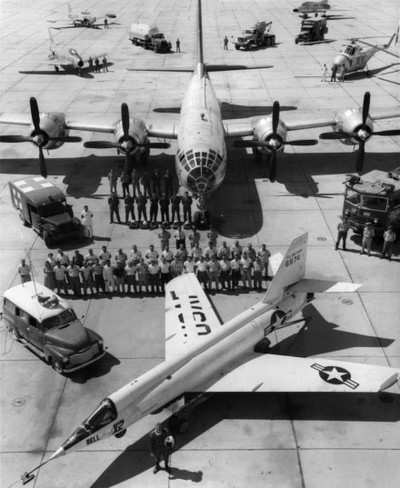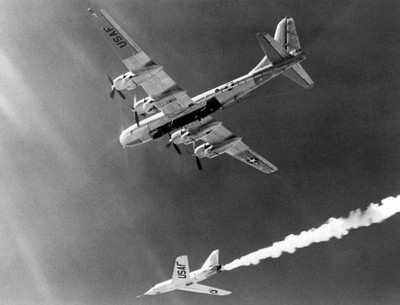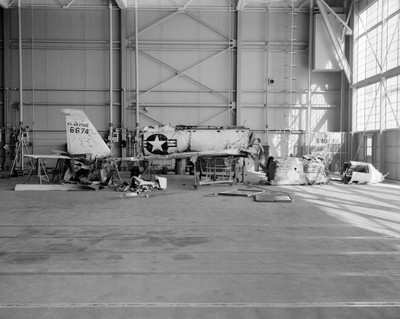Month Marks Two Milestones For Supersonic Flight
September 2006 marks the 50th anniversary of two aerospace
milestones that involved both triumph and tragedy for the flight
test community at Edwards Air Force Base.

It was in September 1956 that the highest and fastest flights of
the Bell X-2, a swept-wing, rocket-powered research aircraft were
flown. Sadly, the latter of those two missions cost the life of Air
Force Capt. Milburn "Mel" Apt, one of the test pilots assigned to
the project.
The X-2 was flown in a joint program to investigate the problems
of aerodynamic heating, stability and control effectiveness at high
speeds and altitudes. Project management was shared by the U.S. Air
Force and Bell Aircraft Co., but the National Advisory Committee
for Aeronautics' High Speed Flight Station, now the Dryden Flight
Research Center, participated in supporting research, wind-tunnel
and rocket-powered model tests and data analysis.
Bell built two X-2 aircraft, designed to be carried to launch
altitude beneath a modified B-50 bomber and released for unpowered
and powered research flights. In 1952, while Bell technicians
fitted the first vehicle with its rocket engine, the second X-2
began glide tests at Edwards Air Force Base, CA. After being
returned to Bell in 1953 for engine installation, the second X-2
was lost in a catastrophic accident during a captive-carry
flight.
During a series of high-speed flights in 1955 and 1956, Air
Force Lt. Col. Frank K. "Pete" Everest piloted the remaining X-2 in
increasing speed increments in an attempt to reach three times the
speed of sound, or Mach 3. He eventually achieved a speed of Mach
2.87 in the X-2, just short of the Mach 3 goal. Dubbed the "Fastest
Man Alive," Everest was destined to hold the title... but not the
speed record in the X-2.

The Air Force next initiated a series of altitude expansion
flights with Capt. Iven C. Kincheloe as project pilot. On September
7, 1956, he began his third high-altitude mission with release from
the B-50 at an altitude of 29,000 feet.
Kincheloe ignited the XLR-25 rocket engine and pulled the X-2
into a climb, eventually reaching a speed of 1,700 mph. The engine
shut down at 90,000 feet as its fuel was depleted and the X-2
coasted to an altitude of 126,200 feet, experiencing a state of
near weightlessness as the X-2 passed the top of its semi-ballistic
arc. The airplane, well above 90 percent of the Earth's atmosphere,
rolled into a left bank as its aerodynamic controls lost
effectiveness due to the thin air. Once the X-2 descended to 40,000
feet, Kincheloe returned the vehicle to level flight and glided to
a landing at Edwards. This first manned fight above 100,000 feet
earned him the sobriquet "First of the Space Men," even though the
altitude reached was well below the levels later defined by
military and civil authorities as being in space.
Following the Air Force test program, NACA director Dr. Hugh L.
Dryden requested that the X-2 be transferred to the NACA for
aerodynamic and structural-heating studies, but the Air Force
delayed turning it over to the civilian agency in the hope of
attaining Mach 3. The service requested and received a two-month
extension to qualify another Air Force test pilot in the
airplane.
Capt. Milburn "Mel" Apt was assigned to the X-2 program in
February 1956 and flew several chase missions in support of
Kincheloe's altitude flights. Finally, in September 1956, he was
offered the opportunity to fly the X-2 himself. After several
ground briefings in the simulator, Apt -- with no previous rocket
plane experience -- was scheduled to make his first flight on Sept.
27. Just before the flight Kincheloe, who would perform chase
duties, expressed his confidence in Apt's abilities.

"You've got it hacked, Dad," he told Apt.
After being lofted to altitude and released, Apt raced the X-2
away from the B-50 under full power, quickly outdistancing the
F-100 chase planes. At high altitude, he nosed over, accelerating
rapidly. The X-2 reached Mach 3.2 (2,094 mph) at 65,500 feet and
Apt became the first man to fly more than three times the speed of
sound.
He never got to celebrate his victory.
Still above Mach 3, Apt began an abrupt turn back toward
Edwards. The maneuver proved fatal as the X-2 began a series of
diverging rolls and tumbled out of control. Apt was unable to
successfully complete the escape sequence and perished in the
subsequent crash. He had flown a perfect flight profile and broken
Everest's record, but was unable to claim the title of "Fastest Man
Alive."

Despite difficulties throughout the X-2 program, the NACA was
able to salvage useful data regarding the challenges of high-speed
and high-altitude flight, aerodynamic heating and aircraft control.
Even Apt's fatal accident provided valuable lessons about
aerodynamic design problems for supersonic airplanes, including the
inertial coupling problem that resulted in Apt's loss of control
and cost him his life.
(Aero-News thanks Peter Merlin, NASA Dryden History Office
for his report)
 ANN's Daily Aero-Linx (04.15.24)
ANN's Daily Aero-Linx (04.15.24) Classic Aero-TV: 'No Other Options' -- The Israeli Air Force's Danny Shapira
Classic Aero-TV: 'No Other Options' -- The Israeli Air Force's Danny Shapira Aero-News: Quote of the Day (04.15.24)
Aero-News: Quote of the Day (04.15.24) Airborne 04.16.24: RV Update, Affordable Flying Expo, Diamond Lil
Airborne 04.16.24: RV Update, Affordable Flying Expo, Diamond Lil ANN's Daily Aero-Term (04.16.24): Chart Supplement US
ANN's Daily Aero-Term (04.16.24): Chart Supplement US






